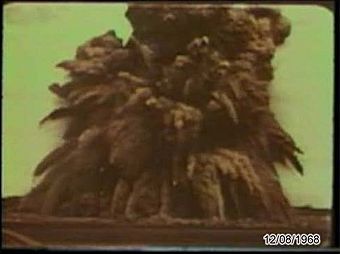Operation Bowline facts for kids
Quick facts for kids Operation Bowline |
|
|---|---|

Bowline Schooner
|
|
| Information | |
| Country | United States |
| Test site |
|
| Period | 1968–1969 |
| Number of tests | 47 |
| Test type | cratering, underground shaft, tunnel |
| Max. yield | 1.2 megatonnes of TNT (5.0 PJ) |
| Navigation | |
| Previous test series | Operation Crosstie |
| Next test series | Operation Mandrel |
Operation Bowline was a series of 47 nuclear tests carried out by the United States. These tests happened between 1968 and 1969. They were part of a larger program of nuclear testing.
This series followed the Operation Crosstie tests and came before the Operation Mandrel series.
Contents
What Was Operation Bowline?
Operation Bowline was a group of 47 nuclear tests. These tests were done by the United States. They took place from 1968 to 1969. Most of these tests happened deep underground.
Where Did the Tests Happen?
All the tests in Operation Bowline took place at the Nevada Test Site (NTS). This site is located in Nevada, USA. The NTS has different areas where tests were conducted. These included:
- Rainier Mesa (Area 12)
- Shoshone Mountain (Area 16)
- Pahute Mesa (Areas 19 and 20)
- Frenchman Flat (Areas 5 and 11)
- Yucca Flat (Areas 1–4, 6–10)
Types of Tests
The tests in Operation Bowline used different methods:
- Underground Shafts: Most tests involved placing the nuclear device deep in a vertical hole, or shaft. This was then sealed before the explosion.
- Tunnels: Some tests were done in horizontal tunnels dug into mountainsides.
- Cratering: One test, called Schooner, was designed to create a large crater on the surface. This was part of a project to explore peaceful uses for nuclear explosions.
How Powerful Were the Explosions?
The power of a nuclear explosion is called its "yield." It is measured in kilotons (kt) or megatons (Mt) of TNT. One kiloton is equal to 1,000 tons of TNT. One megaton is equal to 1,000,000 tons of TNT.
The biggest explosion in Operation Bowline was the Benham test. It had a yield of 1.2 megatons. This is a very powerful explosion.
Key Tests in Operation Bowline
Here are some of the important tests that happened during Operation Bowline. Each test had a specific purpose.
Some tests were part of a program called Operation Plowshare. This project aimed to find peaceful uses for nuclear explosions.
Stoddard Test
The Stoddard test happened on September 17, 1968. It had a yield of 31 kilotons. This test was part of Project Plowshare. Scientists wanted to develop devices that could create clean excavations.
Schooner Test
The Schooner test took place on December 8, 1968. It had a yield of 30 kilotons. This was a cratering experiment. It was done in hard, dry rock. The goal was to see if nuclear explosions could be used for digging large holes.
Weapons Development and Safety Experiments
Many tests in Operation Bowline were for developing new nuclear weapons. Others were safety experiments. These checked how safe the weapons were.
Sled Test
The Sled test was conducted on August 29, 1968. It was a large underground shaft test. Its purpose was to help develop new weapons. It had a yield of 200 kilotons.
Benham Test
The Benham test was the most powerful in the series. It happened on December 19, 1968. This underground shaft test had a yield of 1.2 megatons. It was also for weapons development.
Tyg Tests
On December 12, 1968, six separate tests named Tyg (1 through 6) happened at the same time. These were all underground shaft tests. Their purpose was to develop weapons.
Ipecac Tests
On May 27, 1969, two Ipecac tests (1 and 2) happened at the same time. These were safety experiments. They were done in separate holes.
Fallout and Environmental Impact
Some of the tests caused "venting." This means that radioactive materials escaped into the air. This could happen on the test site or even off-site. Scientists carefully monitored this.
Images for kids


